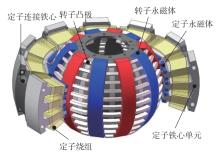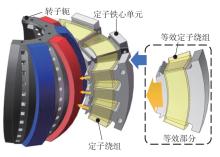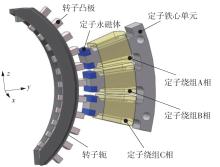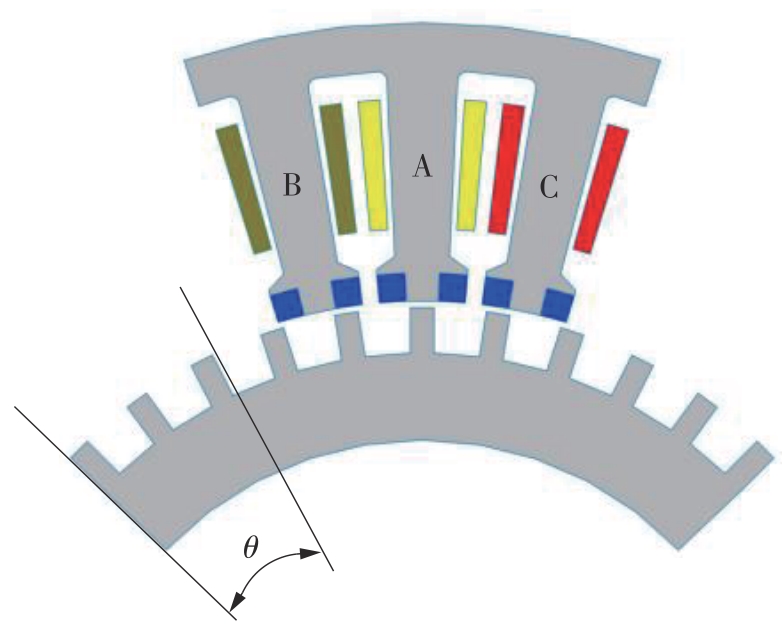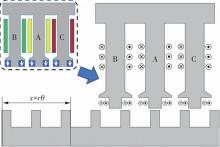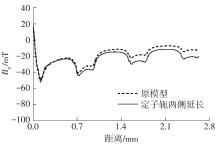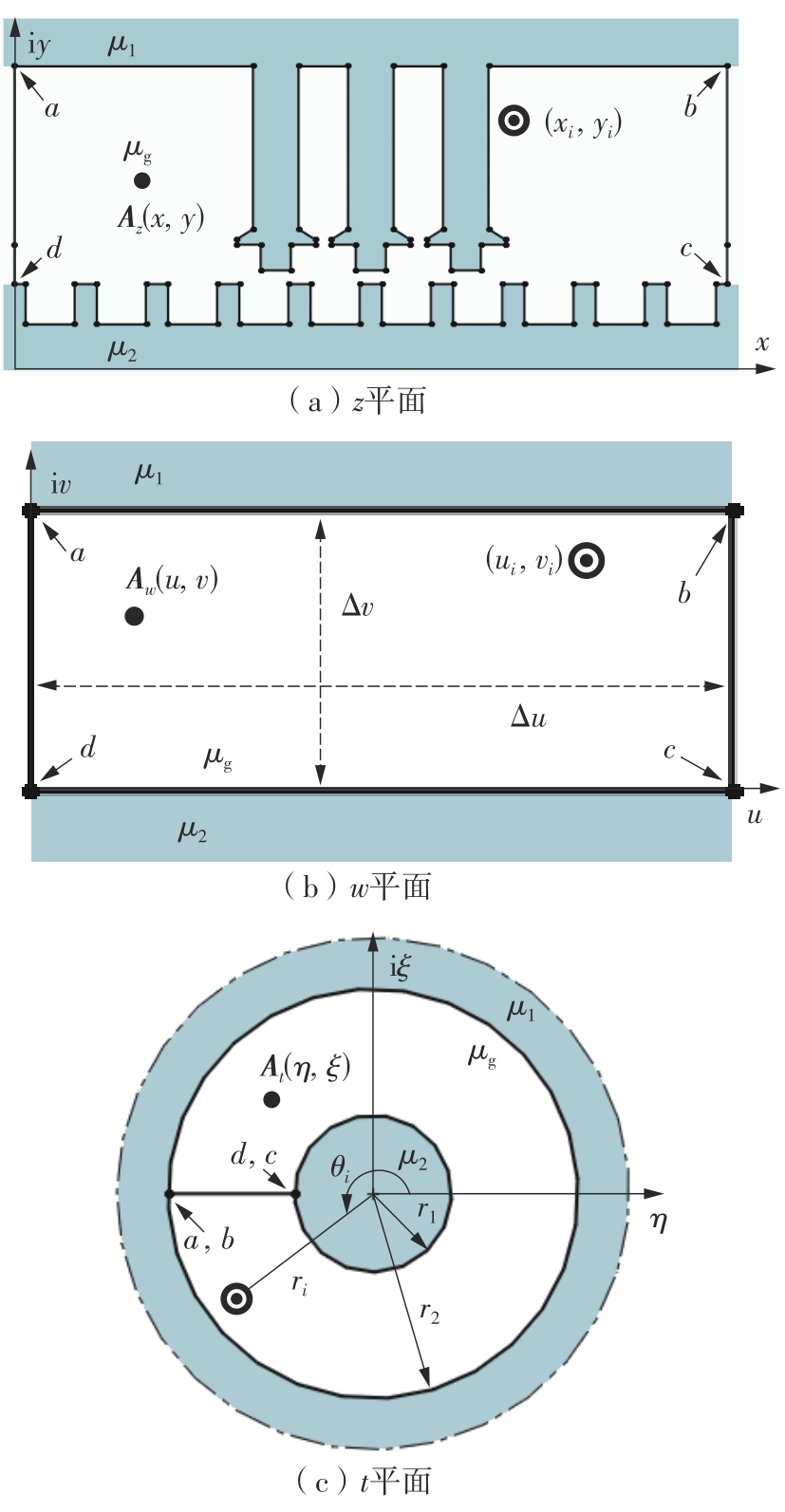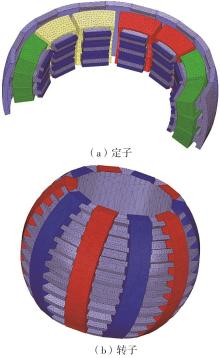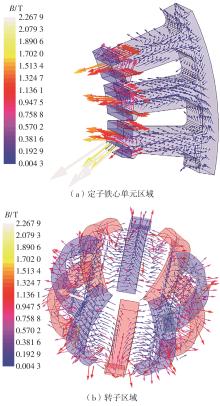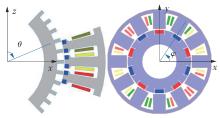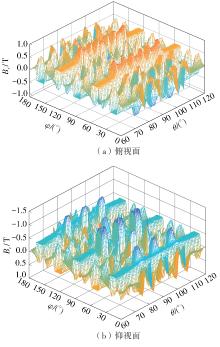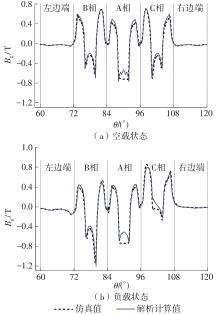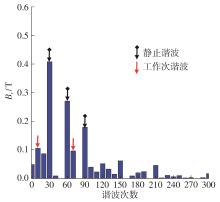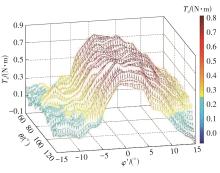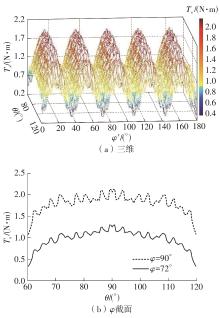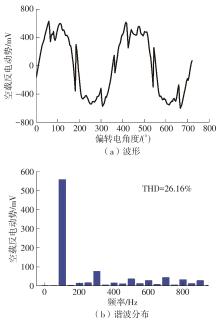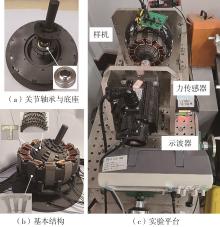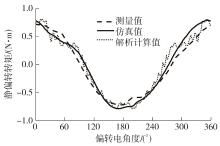Journal of South China University of Technology(Natural Science Edition) ›› 2023, Vol. 51 ›› Issue (12): 95-106.doi: 10.12141/j.issn.1000-565X.220610
Special Issue: 2023年能源、动力与电气工程
• Energy, Power & Electrical Engineering • Previous Articles Next Articles
Deflection Magnetic Field Analysis and Deflection Torque Calculation of a Hybrid Excitation Multi-Degree of Freedom Spherical Motor
CAO Jianghua1 ZENG Bingsen1 YANG Xiangyu1 QIU Xiaohua1,2
- 1.School of Electric Power Engineering, South China University of Technology, Guangzhou 510640, Guangdong, China
2.Research and Development Centre, Guangdong Meizhi Compressor Co. , Ltd. , Foshan 528000, Guangdong, China
-
Received:2022-09-19Online:2023-12-25Published:2023-05-09 -
About author:曹江华(1982-),女,博士,讲师,主要从事特种电机设计研究。E-mail: caojianghua@scut.edu.cn -
Supported by:the Natural Science Foundation of Guangdong Province(2018A0303130221)
CLC Number:
Cite this article
CAO Jianghua, ZENG Bingsen, YANG Xiangyu, et al. Deflection Magnetic Field Analysis and Deflection Torque Calculation of a Hybrid Excitation Multi-Degree of Freedom Spherical Motor[J]. Journal of South China University of Technology(Natural Science Edition), 2023, 51(12): 95-106.
share this article
| 1 | FERNANDES J F P, BRANCO P J C,et al .The shell-like spherical induction motor for low-speed traction:electromagnetic design,analysis,and experimental tests[J].IEEE Transactions on Industrial Electronics,2016,63(7):4325-4335. |
| 2 | KASASHIMA N, ASHIDA K, YANO T,et al .Torque control method of an electromagnetic spherical motor using torque map[J].IEEE/ASME Transactions on Mechatronics,2016,21(4):2050-2060. |
| 3 | LI H F, LI T M .End-effect magnetic field analysis of the Halbach array permanent magnet spherical motor[J].IEEE Transactions on Magnetics,2018,54(4):1-9. |
| 4 | 李斌,张硕,李桂丹,等 .基于球谐函数的动量球定子磁场分析[J].电工技术学报,2018,33(23):5442-5448. |
| LI Bin, ZHANG Shuo, LI Guidan,et al .Stator magnetic field analysis of reaction sphere based on spherical harmonics[J].Transactions of China Electrotechnical Society,2018,33(23):5442-5448. | |
| 5 | YAN L, CHEN I M, LIM C K,et al .Design and analysis of a permanent magnet spherical actuator[J].IEEE/ASME Transactions on Mechatronics,2008,13(2):239-248. |
| 6 | BAI K, XU R Y, LEE K M,et al .Design and development of a spherical motor for conformal printing of curved electronics[J].IEEE Transactions on Industrial Electronics,2018,65(11):9190-9200. |
| 7 | HE J X, LI G L, ZHOU R,et al .Optimization of permanent-magnet spherical motor based on Taguchi method[J].IEEE Transactions on Magnetics,2020,56(2):1-7. |
| 8 | 李国丽,孙涛,周睿,等 .基于转矩模型和改进MOPSO的永磁球形电机磁极优化[J].电机与控制学报,2022,26(6):112-120,133. |
| LI Guoli, SUN Tao, ZHOU Rui,et al .Poles optimization of permanent magnet spherical motors based on torque model and improved MAPSO[J].Electric Machines and Control,2022,26(6):112-120,133. | |
| 9 | 王群京,乔元忠,鞠鲁峰,等 .一种凸极式磁阻型球形电机的结构设计[J].电机与控制学报,2021,25(1):90-102. |
| WANG Qunjing, QIAO Yuanzhong, JU Lufeng,et al .Structural design of a salient pole type reluctance spherical motor[J].Electric Machines and Control,2021,25(1):90-102. | |
| 10 | CHAI F, GAN L, YU Y J .Magnetic field analysis of an iron-cored tiered type permanent magnet spherical motor using modified dynamic reluctance mesh method [J].IEEE Transactions on Industrial Electronics,2020,67(8):6742-6751. |
| 11 | GAN L, PEI Y L, CHAI F .Tilting torque calculation of a novel tiered type permanent magnet spherical motor [J].IEEE Transactions on Industrial Electronics,2020,67(1):421-431. |
| 12 | CHAI F, GAN L, CHEN L .A novel tiered type permanent magnet spherical motor and its rotor orientation measurement principle[J].IEEE Access,2020(8):15303-15312. |
| 13 | CHO S, LIM J S, OH Y J,et al .A study on output characteristics of the spherical multi-dof motor according to the number of phases and pole pitch angles[J].IEEE Transactions on Magnetics,2018,54(11):1-5. |
| 14 | LI Zh, YU X Z, WANG X T,et al .Cogging torque analysis of a special multi-dof permanent magnet motor [C]∥Proceedings of IEEE International Conference on Applied Superconductivity and Electromagnetic Devices (ASEMD).Tianjin:IEEE: 1-2. |
| 15 | XU L, ZHAO W X, JI J H,et al .Design and analysis of a new linear hybrid excited flux reversal motor with inset permanent magnets[J].IEEE Transactions on Magnetics,2014,50(11):1-4. |
| 16 | 郭凯凯,郭有光 .磁通反向直线旋转永磁电机三维非线性等效磁路模型分析[J].电工技术学报,2020,35(20):4278-4286. |
| GUO Kaikai, GUO Youguang .3D nonlinear equivalent magnetic circuit model analysis of a flux reversal linear rotary permanent magnet machine[J].Transactions of China Electrotechnical Society,2020,35(20):4278-4286. | |
| 17 | DRISCOLL T A, TREFETHEN L N .Schwarz-christoffel mapping[M].Cambridge:Cambridge University Press,2002. |
| 18 | DRISCOLL T A .Schwarz-Christoffel toolbox user’s guide:version 2.3[M].Newark:Department of Mathematical Sciences,University of Delaware,2005. |
| 19 | HAGUE B .Electromagnetic problems in electrical engineering[M].London:Oxford University Press,1929. |
| 20 | ROY D, SENGUPTA M .An experimentally validated novel analytical approach for modeling of a saturated switched reluctance motor[J].IEEE Transactions on Magnetics,2022,58(12):1-11. |
| 21 | KIMIABEIGI M, WIDMER J D, LONG R,et al .High-performance low-cost electric motor for electric vehicles using ferrite magnets[J].IEEE Transactions on Industrial Electronics,2016,63(1):113-122. |
| 22 | 李争,何威,刘令旗,等 .混合驱动式永磁转子三自由度电机的磁场分析和转矩计算[J].电工技术学报,2018,33(s1):49-57. |
| LI Zheng, HE Wei, LIU Lingqi,et al .Magnetic field analysis and torque calculation of hybrid drive type permanent magnet three-degree-of-freedom motor[J].Transactions of China Electrotechnical Society,2018,33(s1):49-57. | |
| 23 | CHAI F, GAN L, PEI Y L,et al .Tilting torque analysis of an iron-cored tiered-type permanent magnet spherical motor[J].IEEE Transactions on Industrial Electronics,2021,68(7):6121-6130. |
| [1] | ZHANG Yongshun, LIU Zhijun, LIU Zhenhu, WANG Li. Design and Disturbance Suppression of a Permanent Magnet Flexible Spherical Wrist Driven by Rotating Magnetic Coaxial Effect [J]. Journal of South China University of Technology(Natural Science Edition), 2025, 53(4): 102-112. |
| [2] | ZHANG Tie, CHEN Yijie, ZOU Yanbiao. Robot Collision Detection Based on External Torque Observer [J]. Journal of South China University of Technology(Natural Science Edition), 2024, 52(3): 84-92. |
| [3] | XIE Zhihui, LIU Hanyu, WU Jiechang, et al. Numerical Analysis with Thermal-Magnetic-Fluid Coupling on Enhanced Heat Transfer for Shell-and-Tube Heat Exchanger [J]. Journal of South China University of Technology(Natural Science Edition), 2023, 51(3): 22-32. |
| [4] | YU Mingquan, ZHAO Jiyun, MAN Jiaxiang, et al.. Study on Flow Distribution Mechanism of Low Speed High Torque Hydraulic Motor [J]. Journal of South China University of Technology(Natural Science Edition), 2023, 51(11): 101-109. |
| [5] | CHAI Bosen, WANG Guangyi, ZHU Guoren, et al. Large Eddy Simulation Flow Field Analysis and Visualization Test Verification of Hydraulic Torque Converter Under Braking Condition [J]. Journal of South China University of Technology(Natural Science Edition), 2022, 50(3): 95-105. |
| [6] | ZHANG Fuchen, LI Hongmei, ZHAO Chuntian, et al. On the Relationship Between Stress/Excited Magnetic Field and Magneto-Mechanical Effect [J]. Journal of South China University of Technology(Natural Science Edition), 2022, 50(3): 133-139. |
| [7] | LI Gang, LI Feng, DING Ruqi, et al. Terminal Force Soft Sensing of Hydraulic Manipulator Based on Joint Torque Compensation [J]. Journal of South China University of Technology(Natural Science Edition), 2022, 50(10): 140-152. |
| [8] | CHEN Zhijian, WANG Yuchen, HUANG Pengcheng, et al. Design of Ultra-Wideband Active Magnetic Field Probe for Near-Field Measurement [J]. Journal of South China University of Technology (Natural Science Edition), 2021, 49(6): 131-140. |
| [9] | LUO Yutao, ZHOU Tianyang, XU Xiaotong. Time-Varying LQR Control of Four-Wheel Steer /Drive Vehicle Based on Genetic Algorithm [J]. Journal of South China University of Technology (Natural Science Edition), 2021, 49(3): 114-122. |
| [10] | HOU Liang, LAI Weiqun, CUI Kai, et al. Modeling and Analysis of Oil Film Lubrication Characteristics of Valve-Plate Pair in Axial Piston Motor [J]. Journal of South China University of Technology(Natural Science Edition), 2021, 49(2): 99-109,139. |
| [11] | GUO Lie, GE Pingshu, XU Linna, et al. Stability Control for Distributed Drive Electric Vehicle Under Steering Condition [J]. Journal of South China University of Technology (Natural Science Edition), 2020, 48(3): 100-107. |
| [12] | YIN Huajie, GUO Zhiyu, ZENG Jun. Simplified Predictive Torque Control for Induction Motor with Sliding Mode Speed-Sensorless [J]. Journal of South China University of Technology(Natural Science Edition), 2020, 48(12): 18-26. |
| [13] | LIANG Jia SONG Xuding Lü Pengmin WEI Yongxiang Lü Chang. Fatigue Test and Fatigue Reliability Evaluation of Wheel Loader Drive Axle [J]. Journal of South China University of Technology (Natural Science Edition), 2018, 46(7): 116-122. |
| [14] |
NIU Zhihui SU Jian ZHANG Yirui LIN Huiying WANG Xiugang.
Measurement Method of the Bogie Gravity Center Based on Moment Balance Principle
|
| [15] | XIONG Huiyuan HE Shan ZHA Hongshan ZHU Xionglai. Control Strategy of Driving Torque Distribution for Two-Axle Drive Electric Vehicles#br# [J]. Journal of South China University of Technology(Natural Science Edition), 2018, 46(11): 117-124. |
| Viewed | ||||||
|
Full text |
|
|||||
|
Abstract |
|
|||||
